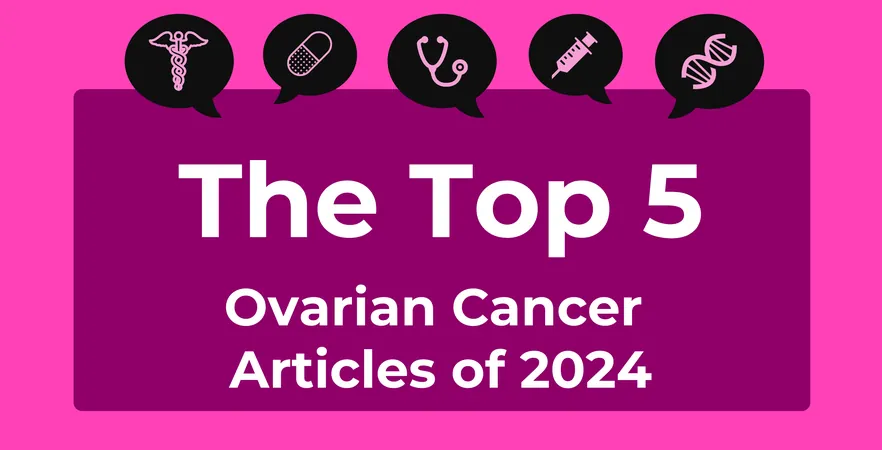
The 5 Most Impactful Ovarian Cancer Discoveries of 2024: What You Need to Know!
2024-12-29
Author: John Tan
The 5 Most Impactful Ovarian Cancer Discoveries of 2024: What You Need to Know!
As 2024 progresses, significant insights into ovarian cancer have emerged, shedding light on risk factors, treatment options, and early detection strategies. This year's research highlights critical areas that may change the landscape of ovarian cancer care. Here, we present the five most influential findings that have captured public attention.
5. Surgical and Chemotherapy Interventions: Lifesavers for Patients with Liver Metastases
A groundbreaking study published in May highlighted that surgical interventions and chemotherapy are pivotal for improving overall survival (OS) and cancer-specific survival (CSS) in ovarian cancer patients with liver metastases. Historically overlooked, this research revealed that patients undergoing these treatments not only have better survival rates but also face distinct morbidity and mortality outcomes. This uplifts the importance of aggressive treatment approaches in high-risk populations and may encourage more personalized treatment plans.
4. The Hidden Risk of Cardiovascular Mortality in Ovarian Cancer Patients
Research findings from May uncovered that age, tumor metastasis, and surgical treatment significantly impact cardiovascular mortality (CVM) in ovarian cancer patients. Alarmingly, over 50% of patients over 60 years old are at risk of CVM. Those who underwent surgical treatment had a markedly lower risk, emphasizing the potential need for cardiovascular monitoring during ovarian cancer treatment. With the data suggesting a strong correlation between disease progression and heart health, further investigations are required to refine patient care strategies.
3. Falling Morbidity and Mortality Rates Among Patients with Liver Metastases
In April, a compelling study documented a decrease in both morbidity and mortality rates among ovarian cancer patients with liver metastases. This positive trend indicates the effectiveness of current treatment modalities, particularly surgery and chemotherapy, in prolonging patient lives. The decrease in incidence rate offers hope for enhanced therapeutic strategies and may signify advancements in understanding the disease’s pathology, encouraging further exploration into factors influencing these outcomes.
2. Air Pollution and Ovarian Cancer: A Troubling Link
A study from October unveiled a disturbing connection between elevated nitrogen dioxide (NO2) levels and increased ovarian cancer incidence. The data suggested that even minimal increases in NO2 exposure correspond to higher ovarian cancer diagnosis rates, particularly among premenopausal women. This finding raises significant concerns regarding environmental health and calls for public health interventions to mitigate air pollution, underlining the urgency to consider environmental factors in cancer risk assessments.
1. Early Detection Breakthrough: Symptom-Triggered Testing Proves Effective
A pivotal August study revealed that approximately 25% of women diagnosed with high-grade serous ovarian cancer through symptom-triggered testing were found to be in early-stage disease. The success of this "fast-track pathway" not only emphasizes the importance of recognizing symptoms but also highlights the potential of refining diagnostic processes to enhance survival outcomes. The implications of these findings could lead to new guidelines in cancer screening, promoting the importance of patient-reported symptoms in clinical settings.
Ovarian cancer continues to challenge researchers and healthcare professionals, but 2024 has already delivered promising insights. As these studies gain traction, they could reshape treatment protocols and improve outcomes for thousands of women battling this aggressive disease. Stay informed and advocate for comprehensive ovarian cancer care!




 Brasil (PT)
Brasil (PT)
 Canada (EN)
Canada (EN)
 Chile (ES)
Chile (ES)
 España (ES)
España (ES)
 France (FR)
France (FR)
 Hong Kong (EN)
Hong Kong (EN)
 Italia (IT)
Italia (IT)
 日本 (JA)
日本 (JA)
 Magyarország (HU)
Magyarország (HU)
 Norge (NO)
Norge (NO)
 Polska (PL)
Polska (PL)
 Schweiz (DE)
Schweiz (DE)
 Singapore (EN)
Singapore (EN)
 Sverige (SV)
Sverige (SV)
 Suomi (FI)
Suomi (FI)
 Türkiye (TR)
Türkiye (TR)